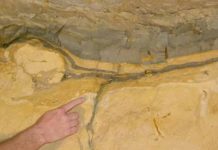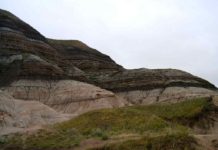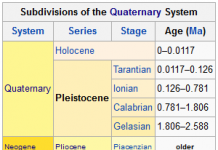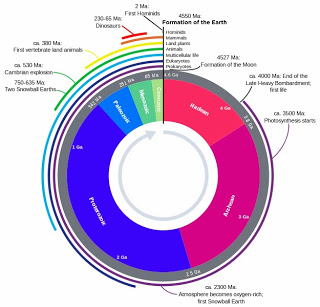
The Mesozoic Era is an interval of geological time from about 252 to 66 million years ago. It is also called the Age of Reptiles, a phrase introduced by the 19th century paleontologist Gideon Mantell who viewed it as dominated by reptiles such as Iguanadon, Megalosaurus, Plesiosaurus and what are now called Pseudosuchia.
Mesozoic means “middle life”, deriving from the Greek prefix meso-/μεσο- for “between” and zōon/ζῷον meaning “animal” or “living being”. It is one of three geologic eras of the Phanerozoic Eon, preceded by the Paleozoic (“ancient life”) and succeeded by the Cenozoic (“new life”). The era is subdivided into three major periods: the Triassic, Jurassic, and Cretaceous, which are further subdivided into a number of epochs and stages.
The era began in the wake of the Permian–Triassic extinction event, the largest well-documented mass extinction in Earth’s history, and ended with the Cretaceous–Paleogene extinction event, another mass extinction which is known for having killed off non-avian dinosaurs, as well as other plant and animal species.
The Mesozoic was a time of significant tectonic, climate and evolutionary activity. The era witnessed the gradual rifting of the supercontinent Pangaea into separate landmasses that would eventually move into their current positions. The climate of the Mesozoic was varied, alternating between warming and cooling periods. Overall, however, the Earth was hotter than it is today.
Non-avian dinosaurs appeared in the Late Triassic and became the dominant terrestrial vertebrates early in the Jurassic, occupying this position for about 135 million years until their demise at the end of the Cretaceous. Birds first appeared in the Jurassic, having evolved from a branch of theropod dinosaurs. The first mammals also appeared during the Mesozoic, but would remain small—less than 15 kg (33 lb)—until the Cenozoic.
Geologic periods
- Triassic (252.2 to 201.3 million years ago)
- Jurassic (201.3 to 145 million years ago)
- Cretaceous (145 to 66 million years ago)
Paleogeography and tectonics
Climate
The Triassic was generally dry, a trend that began in the late Carboniferous, and highly seasonal, especially in the interior of Pangaea. Low sea levels may have also exacerbated temperature extremes. With its high specific heat capacity, water acts as a temperature-stabilizing heat reservoir, and land areas near large bodies of water—especially the oceans—experience less variation in temperature. Because much of the land that constituted Pangaea was distant from the oceans, temperatures fluctuated greatly, and the interior of Pangaea probably included expansive areas of desert. Abundant red beds and evaporites such as halite support these conclusions, but evidence exists that the generally dry climate of the Triassic was punctuated by episodes of increased rainfall. Most important humid episodes were the Carnian Pluvial Event and one in the Rhaetian, few million years before the Triassic-Jurassic extinction event.
Sea levels began to rise during the Jurassic, which was probably caused by an increase in seafloor spreading. The formation of new crust beneath the surface displaced ocean waters by as much as 200 m (656 ft) more than today, which flooded coastal areas. Furthermore, Pangaea began to rift into smaller divisions, bringing more land area in contact with the ocean by forming the Tethys Sea. Temperatures continued to increase and began to stabilize. Humidity also increased with the proximity of water, and deserts retreated.
The climate of the Cretaceous is less certain and more widely disputed. Higher levels of carbon dioxide in the atmosphere are thought to have caused the world temperature gradient from north to south to become almost flat: temperatures were about the same across the planet. Average temperatures were also higher than today by about 10°C. In fact, by the middle Cretaceous, equatorial ocean waters (perhaps as warm as 20°C in the deep ocean) may have been too warm for sea life, and land areas near the equator may have been deserts despite their proximity to water. The circulation of oxygen to the deep ocean may also have been disrupted. For this reason, large volumes of organic matter that was unable to decompose accumulated, eventually being deposited as “black shale”.
Not all of the data support these hypotheses, however. Even with the overall warmth, temperature fluctuations should have been sufficient for the presence of polar ice caps and glaciers, but there is no evidence of either. Quantitative models have also been unable to recreate the flatness of the Cretaceous temperature gradient.
Different studies have come to different conclusions about the amount of oxygen in the atmosphere during different parts of the Mesozoic, with some concluding oxygen levels were lower than the current level (about 21%) throughout the Mesozoic, some concluding they were lower in the Triassic and part of the Jurassic but higher in the Cretaceous, and some concluding they were higher throughout most or all of the Triassic, Jurassic and Cretaceous.
Life
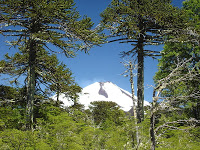
Flora
Fauna
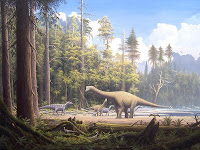
The extinction of nearly all animal species at the end of the Permian Period allowed for the radiation of many new lifeforms. In particular, the extinction of the large herbivorous pareiasaurs and carnivorous gorgonopsians left those ecological niches empty. Some were filled by the surviving cynodonts and dicynodonts, the latter of which subsequently became extinct. Some plant species had distributions that were markedly different from succeeding periods; for example, the Schizeales, a fern order, were skewed to the Northern Hemisphere in the Mesozoic, but are now better represented in the Southern Hemisphere.
Recent research indicates that the specialized animals that formed complex ecosystems, with high biodiversity, complex food webs and a variety of niches, took much longer to reestablish, recovery did not begin until the start of the mid-Triassic, 4M to 6M years after the extinction and was not complete until 30M years after the Permian-Triassic extinction event. Animal life was then dominated by large archosaurian reptiles: dinosaurs, pterosaurs, and aquatic reptiles such as ichthyosaurs, plesiosaurs, and mosasaurs.
The climatic changes of the late Jurassic and Cretaceous provided for further adaptive radiation. The Jurassic was the height of archosaur diversity, and the first birds and eutherian mammals also appeared. Angiosperms radiated sometime in the early Cretaceous, first in the tropics, but the even temperature gradient allowed them to spread toward the poles throughout the period. By the end of the Cretaceous, angiosperms dominated tree floras in many areas, although some evidence suggests that biomass was still dominated by cycad and ferns until after the Cretaceous–Paleogene extinction.
Some have argued that insects diversified with angiosperms because insect anatomy, especially the mouth parts, seems particularly well-suited for flowering plants. However, all major insect mouth parts preceded angiosperms and insect diversification actually slowed when they arrived, so their anatomy originally must have been suited for some other purpose.
As the temperatures in the seas increased, the larger animals of the early Mesozoic gradually began to disappear while smaller animals of all kinds, including lizards, snakes, and perhaps primates, evolved. The Cretaceous–Paleogene extinction event exacerbated this trend. The large archosaurs became extinct, while birds and mammals thrived, as they do today.


